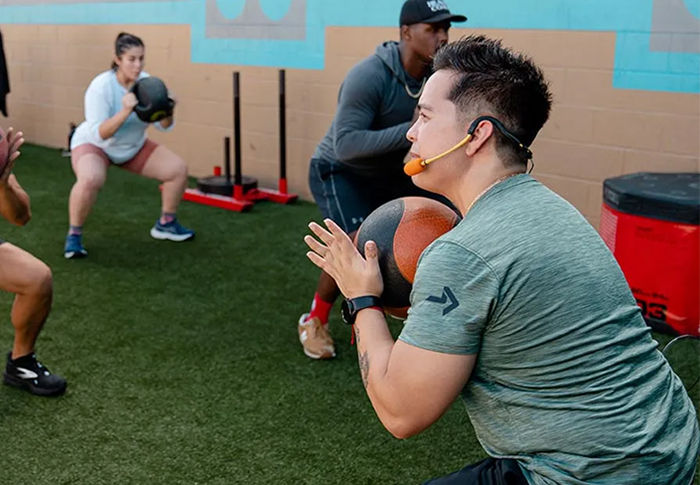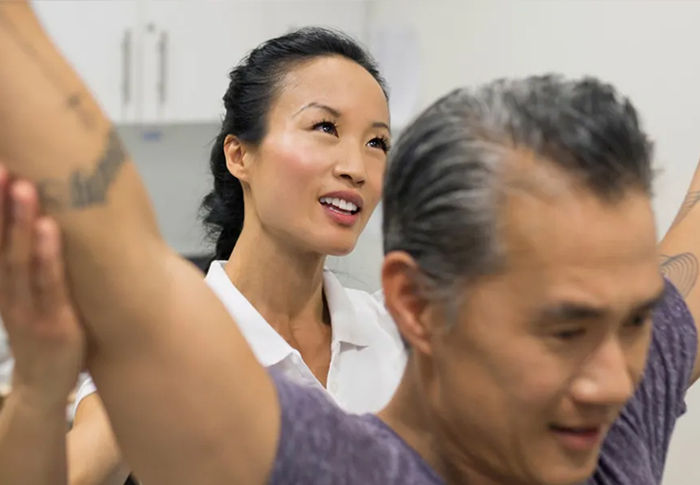
When I was at the peak of my fitness career, I was teaching 15 classes a week at my studio. But not just verbally teaching them, I was actually participating in them while I taught. This was in addition to my own workouts and the workouts I would sometimes do with my personal-training clients. I also found myself frequently getting sick and injured and struggled with extreme exhaustion. While I can’t say for certain whether I had overtraining syndrome (OTS), I certainly was burned out and headed in that direction.
What is OTS? Unfortunately, it’s poorly defined, according to a 2022 review in the International Journal of Sports Physiology and Performance. In fact, these researchers could find no studies to include in their review that clearly, effectively and objectively defined what OTS is. The closest definition they could come up with was that OTS is “a sports-specific decrease in performance together with disturbances in mood state. Underperformance persists despite a period of recovery lasting weeks or months.”

While OTS is traditionally applied to athletes and military professionals, as an exercise and health professional, you and your clients, participants and athletes may be at risk of developing OTS. In this article, we’ll try to clarify what OTS is, signs and symptoms to watch out for, how to prevent it and what to do if you or a client is exhibiting signs and symptoms of OTS.
Is it OTS or Overreaching?
As a health and exercise professional, you know that to experience gains in any physical capacity—including musculoskeletal and cardiorespiratory—the body must be exposed to resistance greater than its baseline. For example, if a person normally walks a flat surface for cardio activity, to make any improvements in cardiorespiratory fitness, they must increase duration, frequency and/or intensity. The same principles apply to building muscular strength, endurance and power, or improving skills like balance and coordination.
But there’s one area that is often not emphasized regarding fitness improvements: rest and recovery. The body also requires times of rest so that cells can regenerate and microinjuries can be repaired. When the body is not given this time, it is referred to as overreaching. When overreaching occurs, performance declines.

Overreaching isn’t always a negative thing, though. Sometimes, it’s planned and brought on purposely; this is referred to as functional overreaching. This type of overreach is thought to stimulate adaptation and future performance improvements. When overreaching is unplanned, it’s referred to as nonfunctional. In this case, it can lead to more prolonged performance decreases. And if not caught and corrected, it can lead to OTS.
“An enduringly damaging fitness culture myth is that the more work one puts in, the better it gets,” says Nick Bach, PsyD, a licensed clinical psychologist. “Coaching can really be a mechanism to change that, by the coach acting from the consciousness of health as strategic restraint and whole-person awareness.” In other words, you can push back on the “more is better” myth by recommending strategic restraint—balancing training stress with recovery and the client’s broader life demands—to protect health and performance and prevent overtraining.
“Coaches and trainers are responsible for maintaining the crucial balance between functional and nonfunctional overreaching,” says Colin Tomes, PhD, DPT, a professor and physical therapist specializing in tactical health and human performance. “If mismanaged, overreaching may manifest as OTS.”
Beyond Performance: How OTS Disrupts the Gut–Brain–Immune Axis
When OTS is not addressed and is allowed to progress, its effects go even deeper than just performance.
“Long-term OTS dysregulates the hypothalamic-pituitary-adrenal (HPA) axis—the stress response system of the brain—suppresses immune function, increases levels of pro-inflammatory cytokines and disrupts gut-brain signaling. This is in addition to exponentially increasing the risk of chronic disease and mental decline,” explains Bach.
Chronic stress, which is essentially what OTS shows up as in the body, can be a root cause of gut dysbiosis. As Hippocrates is credited with saying, “All disease begins in the gut.” The gut’s microbiome is made up of trillions of microorganisms, both beneficial and harmful. OTS disrupts the gut’s delicate balance of microorganisms, creating dysbiosis. This, in turn, increases the risk of inflammation and disease. This highlights the importance of preventing OTS and making sure it is properly addressed when it does occur.
For health and exercise professionals, the takeaway is clear: OTS isn’t just “too much training”—it’s a whole-system stress injury. Screen early for red flags (sleep disruption, mood changes, gastrointestinal issues, recurrent illness), reduce load, prioritize recovery nutrition and sleep, and refer your client to a clinician if symptoms persist. Protecting the gut–brain–immune axis is central to restoring health and preventing relapse.
Signs and Symptoms of OTS
So, what are some indicators of OTS? It’s important to note that while OTS may start off as a physical condition, its effects are biopsychosocial (BPS). This refers to a whole-person framework that explains health and performance as the result of interacting biological factors (e.g., physiology, sleep, injury, hormones), psychological (e.g., thoughts, emotions, motivation, coping), and social factors (e.g., relationships, work/school demands, culture, resources). For overtraining, a BPS view means you don’t look only at training load—you also consider stress, perfectionism, mood and life pressures, then adjust programming and supports across all three domains.
“OTS is a systemic condition that affects the athlete physically, mentally and emotionally,” says Eric D Santos, DPT, founder and owner of Santos Physical Therapy in Lisbon, N.H. “Some signs I look for include persistent fatigue that doesn't resolve with rest days, frequent nagging injuries, and decreased performance. If the athlete is putting in more effort but regressing, this should raise concern.”
OTS is a complex medical condition that is multifactorial in nature, says Tomes, which creates a challenge in identifying it. “Nonetheless, there are some cardinal indicators to be aware of, to distinguish between overreaching and overtraining syndrome.” And, as Chris Gagliardi, MS, ACE Scientific Education Content Manager and an ACE Certified Health Coach, Personal Trainer, Group Fitness Instructor and Medical Exercise Specialist, points out, health coaches and exercise professionals may be the first professionals to suspect OTS. Even though exercise professionals and health coaches are not qualified to diagnose OTS, they may recognize important signs and symptoms and refer their clients to more qualified professionals.
According to Tomes, the earliest sign of OTS “is a stall or decline in performance despite continued or increased training. Many individuals with OTS present with undesired or unplanned changes in body weight or composition, along with alterations in appetite, changes in sleep habits, fatigue, irritability, increased or unrelenting muscle soreness, increased frequency of musculoskeletal injury, new injury or aggravation of old injuries.”
Santos notes that there are objective signs of OTS that a trainer or coach may be able to catch before other symptoms show up. “Other things I might look for would be elevated resting heart rate or disturbed heart-rate variability,” says Santos. “These are objective metrics you can monitor, and they often change before the athlete notices symptoms.”
Tomes agrees. “Wearable technology, smartphone apps and other athlete information is available to coaches and trainers today like never before. Data like heart-rate variability, or HRV, which considers the beat-by-beat changes in heart rate over time, has been shown to be a strong tool for evaluating athlete workloads and overstress in many high-intensity settings.”
With all the technology currently at our fingertips, which can be great for gathering objective data, Tomes reminds us that there’s a person at the other end of it. “It’s important to note that while these data can be useful, it is important not to forget the individual human, as well. Subjective indicators, like soreness and fatigue, as well as simple enthusiasm for training or competition, can be just as valuable as the latest health-tracking metric,” says Tomes. “Data are best applied holistically and in context as a guide, and not as a final determination for an athlete’s readiness.”
How To Prevent OTS
As with any condition, prevention trumps having to treat. According to Tomes, successful intervention for OTS “specifically relies on targeting the underlying principles. While training must apply sufficient stress to bodily tissues and systems to override the body’s natural tendency to conserve energy and nutrients, training must not be so severe that the training targets are outright damaged, or that the session sends the body overall into a state of systemic crisis.”
“Prioritize recovery just as much as training,” urges Santos. “This includes scheduling rest days, de-load weeks, and incorporating modalities like active recovery and mobility work. Promote proper sleep hygiene and fuel adequately.”
“There are no replacements for adequate sleep and a well-planned performance diet,” agrees Tomes. “Without these supporting pillars, even the best designed program could result in overstress and overload.”
Regarding training, Tomes recommends careful planning and deliberate periodization and programming—and ensuring a sufficient resupply of energy and nutrients. “Any scenario in which energy demand exceeds energy supply—for example, skipping meals or adding training sessions without additional provision of food, combined with repetitive loading—may result in OTS.”
OTS can also occur in younger athletes. “One critical area I think we need to talk more about, especially in today’s sports culture, is the importance of variability in training, and the risks of early sport specialization,” says Santos. “More and more, we’re seeing young athletes specializing in a single sport year-round as early as age 8 or 9. While this might seem like a path to elite performance, the evidence actually shows the opposite. Early specialization is strongly associated with higher rates of overuse injuries, mental burnout and shorter athletic careers.”
Santos encourages his athletes to incorporate cross-training, especially in the off-season or early developmental years. “At the end of the day, variability means being strategic about longevity. You’re not just building athletes for this season; you’re helping them lay the foundation for a lifetime of physical activity and performance.”
And therein lies the goal of any health and exercise professional—to lay the foundation of a lifetime of healthy habits for our clients, athletes and participants. OTS can be prevented. Be proactive in educating your clients and serve as their accountability partner, not only on training days but also in encouraging rest and recovery.





 by
by 




